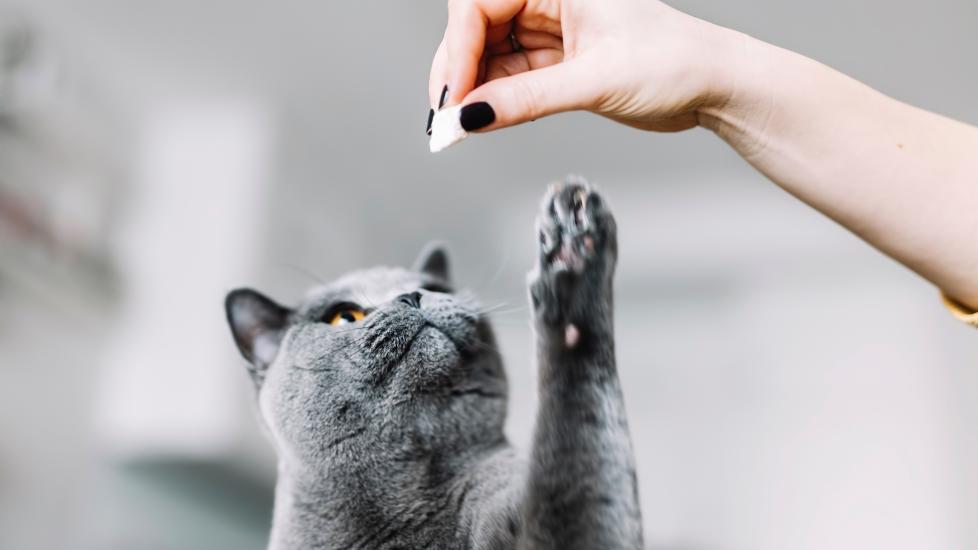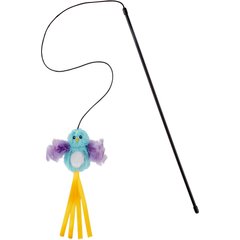How To Clicker Train a Cat
You might think training is just for dogs, but most (if not all) cats can also be trained easily using positive reinforcement. One way to do this is through clicker training.
Clicker training a cat is a great form of mental and physical enrichment. It helps kitties learn good manners (like not scratching the furniture) and fun tricks (like high-fiving), and it also strengthens the human-animal bond. Here’s what you need to know about this method of training for cats.
What Is a Clicker?
A clicker for cat training (also called a marker) is a tool that makes a distinct, consistent, repeatable sound. The clicker is a plastic device that makes a clicking noise used to clearly mark a behavior at the exact time it happens. For example, the moment the cat sits down, the event is marked with a click.
Shop Toys, Training and More
- Feliway Optimum Enhanced Calming 30 Day Diffuser for Cats$29.99Chewy Price
- Purina Pro Plan Veterinary Diets Calming Care Cat Supplement, 30 count$33.99Chewy Price
- Nutramax Solliquin Soft Chew Calming Behavioral Health Supplement for Small/Medium Dogs & Cats, 75 count$19.99Chewy Price
- Frisco Bird with Feathers Teaser Wand Cat Toy with Catnip, Blue$5.99Chewy Price
How Does Clicker Training Work?
The marker’s sound becomes a reinforcer when it’s consistently paired with a treat. This means that while the noise a clicker makes isn’t rewarding per se, it becomes rewarding when accompanied with a tasty treat. When the cat gets a treat every time the click sounds, the cat associates the click with a reward.
In this process, the tool also becomes a bridging stimulus, meaning you are bridging the time from the moment the behavior happens (and marking the behavior with a click) to the time you give the actual reward (the treat).
Using a clicker to mark a behavior you’re looking for can be helpful in training a cat because:
-
The signal is clear. The distinct marker sounds the same every time, and with that consistency, the cat has a chance to learn the behavior quickly.
-
It gets the timing right. When a cat is exhibiting a desirable behavior, it’s far easier to click at that exact moment than to give them a treat. In training, timing is everything—and clicker training helps improve the trainer’s timing.
-
It covers distance. Because the clicker bridges the time from the sound to the reward, it’s a good tool when you need to reward a behavior that happens at a distance, such as when your cat scratches on their tree.
-
It helps with focus. Some cats can get distracted with a treat and seem to focus easier with the sound of the click. The distinct marker can help them learn the cue easier.
-
It’s fun and can keep your cat motivated to learn!
Why Should You Clicker Train a Cat?
You can use clicker training to teach a cat many behaviors, from not jumping on the counter (by clicking the marker when the cat jumps off the counter on cue, or when they’re on the floor) to tricks like sit and stay. There are almost no limitations to what a good trainer can teach a cat to do.
How To Clicker Train a Cat
1. Get the Right Tools
Find a clicker that makes a sound your cat isn’t afraid of. Then, gather a few treats your cat loves. These should be small morsels of food; Churu treats are a great option, and bits of wet food on a spoon work too.
2. Click on Good Behaviors
Begin with a behavior your cat offers easily. For example, if your cat sits easily in front of you, take a few steps back. When your cat comes to you and sits down, immediately click and give the treat. Repeat this in several short sessions until your cat consistently offers the sit behavior.
Remember: The clicker has no meaning to your cat unless it’s paired with a reward. For the first few cat training sessions, make the sound and offer the treat with minimal delay. Repeat this until the cat begins to anticipate the treat when they hear the click.
3. Give a Cue
Begin saying a cue—such as “sit”—right before the cat sits, then click and offer the reward. Soon, the cat will begin associating the cue with the action, and thus with the reward. This teaches them to follow that cue—in this case, to sit on command.
Tips for Clicker Training Cats
-
Keep training sessions short; this helps the cat stay interested
-
Focus on teaching one cue/behavior at a time
-
End on a good note, when the cat is performing well and still engaged with you
-
Do not use the clicker for anything other than training
-
Give high-value treats or toys that you use only for training
-
Give a treat after every click, and give is as quickly as possible when first starting the training
Clicker Training Cats FAQs
How long does it take to clicker train a cat?
Though every cat is different, most cats catch on quickly and enjoy the process. A lot of it depends on the high-value treat: The more the cat enjoys their reward, the faster they usually learn.
While some cats learn a new cue over a few days, others may take weeks. Let the cat set the pace and keep training sessions short. It’s better to do 20 two-minute sessions a week than two 20-minute sessions.
At what age should you clicker train a cat?
Though kittens seem to be easier to train than some adult cats, any cat that is food- or toy-motivated (and not afraid of the clicking sound!) can easily be trained with a clicker. Young and playful cats especially enjoy this kind of interaction with their pet parent.
Can you train a cat without a clicker?
You can certainly train a cat without a clicker. Any behavior that is consistently rewarded will be repeated again. The key is not the clicker, but the reward and timing. The clicker is just a handy tool that allows you to be clear and accurate with timing and reward.
Featured Image: Adobe/Photocreo Bednarek




